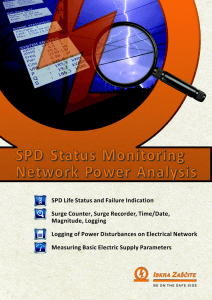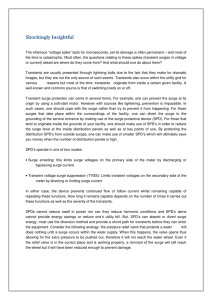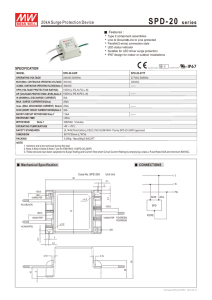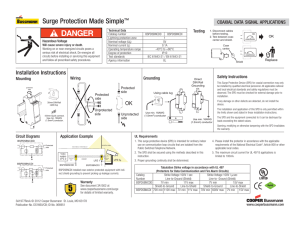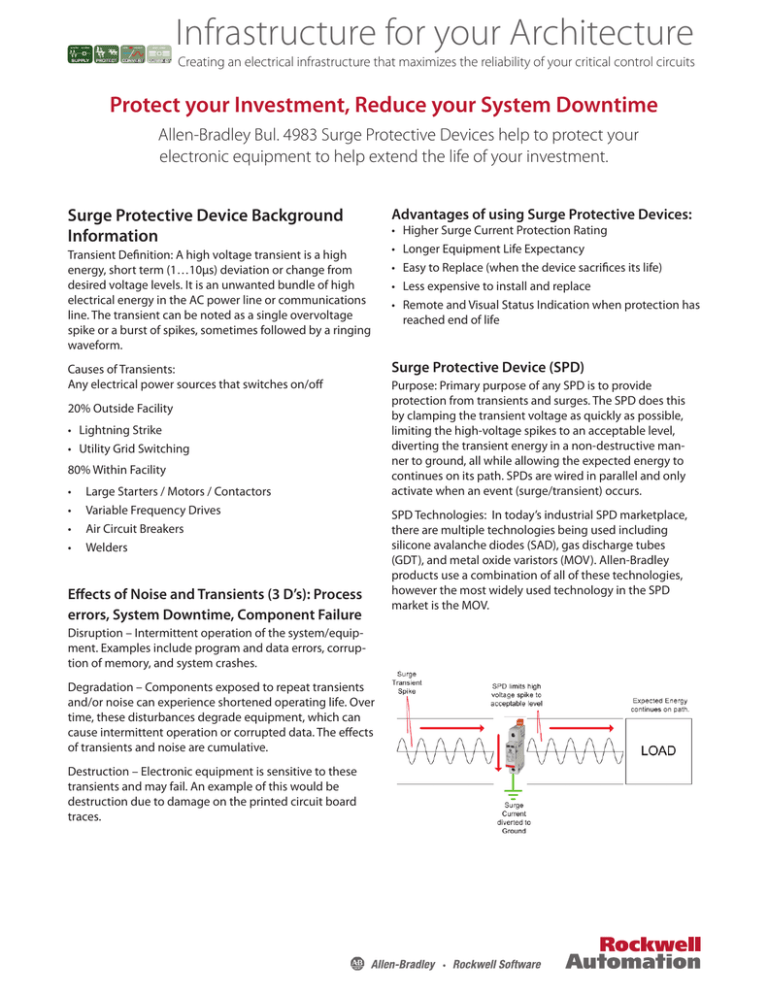
Infrastructure for your Architecture
Creating an electrical infrastructure that maximizes the reliability of your critical control circuits
Protect your Investment, Reduce your System Downtime
Allen-Bradley Bul. 4983 Surge Protective Devices help to protect your
electronic equipment to help extend the life of your investment.
Surge Protective Device Background
Information
Transient Definition: A high voltage transient is a high
energy, short term (1…10μs) deviation or change from
desired voltage levels. It is an unwanted bundle of high
electrical energy in the AC power line or communications
line. The transient can be noted as a single overvoltage
spike or a burst of spikes, sometimes followed by a ringing
waveform.
Causes of Transients:
Any electrical power sources that switches on/off
20% Outside Facility
• Lightning Strike
• Utility Grid Switching
80% Within Facility
•
•
•
•
Large Starters / Motors / Contactors
Variable Frequency Drives
Air Circuit Breakers
Welders
Effects of Noise and Transients (3 D’s): Process
errors, System Downtime, Component Failure
Disruption – Intermittent operation of the system/equipment. Examples include program and data errors, corruption of memory, and system crashes.
Degradation – Components exposed to repeat transients
and/or noise can experience shortened operating life. Over
time, these disturbances degrade equipment, which can
cause intermittent operation or corrupted data. The effects
of transients and noise are cumulative.
Destruction – Electronic equipment is sensitive to these
transients and may fail. An example of this would be
destruction due to damage on the printed circuit board
traces.
Advantages of using Surge Protective Devices:
•
•
•
•
•
Higher Surge Current Protection Rating
Longer Equipment Life Expectancy
Easy to Replace (when the device sacrifices its life)
Less expensive to install and replace
Remote and Visual Status Indication when protection has
reached end of life
Surge Protective Device (SPD)
Purpose: Primary purpose of any SPD is to provide
protection from transients and surges. The SPD does this
by clamping the transient voltage as quickly as possible,
limiting the high-voltage spikes to an acceptable level,
diverting the transient energy in a non-destructive manner to ground, all while allowing the expected energy to
continues on its path. SPDs are wired in parallel and only
activate when an event (surge/transient) occurs.
SPD Technologies: In today’s industrial SPD marketplace,
there are multiple technologies being used including
silicone avalanche diodes (SAD), gas discharge tubes
(GDT), and metal oxide varistors (MOV). Allen-Bradley
products use a combination of all of these technologies,
however the most widely used technology in the SPD
market is the MOV.
MOVs
An MOV is an electronic component with a significant non-linear current/voltage characteristic. When used in a surge
protective device, the MOV is wired in parallel to the circuit and used to divert the excess transient energy to ground.
Essentially when the circuit voltage is below a certain “activation” voltage the device’s resistance is very high therefore
passing a low amount of current through it. However, when the circuit voltage is above the “activation” voltage the
device’s resistance is low and therefore passes a large amount of current through it.
Specification Considerations when selecting Surge Protective Devices:
When selecting or comparing multiple SPDs, it is important to understand the ratings that are being presented as in
many cases these values can be complex and confusing. In this section, some of the key ratings will be described in order
to help develop a better understanding of the significance of these values and what they mean. These ratings are shown
in the 4983 Product Family Brochure in order to make the selection process easier for the customers as shown in the
example on Table 3.
Table 3: Example of the 4983 Product Family Brochure Selection Table
Maximum Continuous Operation Voltage (MCOV):
Maximum value of the voltage that can be applied before
“activating” or “turning on” the SPD. Once this value is
exceeded the MOV starts conducting thus shunting the
excess energy to ground and “clamping” the energy to an
acceptable level.
Voltage Protection Rating (VPR): UL 1449 maximum
rated surge voltage value that will be allowed to pass
through the circuit to the protected load device. This is
the maximum value that is measured after the SPD has
clamped/limited the surge voltage to the load. This is
commonly referred to as the “let-thru” voltage.
• 2
Impulse Surge Current Rating (Iimp): IEC rated peak onetime surge current value of a 10/350μs waveform that
can be safely diverted through the SPD. This 10/350μs
is an ANSI/IEEE C62.41 standard waveform that rises to
90% of the peak surge current value in 10μs and decays
to 50% of the peak surge current value in 350μs (see
Diagram 1). This is a very large energy waveform that can
be considered a “simulated” lightning strike.
Diagram 1: ANSI/IEEE C62.41 10/350μs Waveform Diagram
Maximum Discharge Current Rating (Imax): IEC rated
peak one-time surge current value of a 8/20μs waveform
that can be safely diverted through the SPD. This 8/20μs
waveform is an ANSI/IEEE C62.41 standard waveform that
rises to 90% of the peak surge current value in 8μs and
decays to 50% of the peak surge current value in 10μs
(see Diagram 2). This value is used as a selection value for
the desired protection level in most SPD offerings.
Diagram 2: ANSI/IEEE C62.41 8/20μs Waveform Diagram
Nominal Surge Current Rating (In): UL 1449 rated surge
current value of an 8/20μs waveform (see Diagram 2) that
can be safely diverted through the SPD at a minimum of
15 instances. UL declares the acceptable values for this
test with a maximum value of 20kA.
Diagram 3: Visual representation of the energy level difference between the two test waveforms
• 3
Allen-Bradley, Rockwell Software, and Rockwell Automation are trademarks of Rockwell Automation Inc.
Publication 4983-AT001A-EN-P – June 2011
Copyright ©2011 Rockwell Automation, Inc. All Rights Reserved. Printed in USA.


